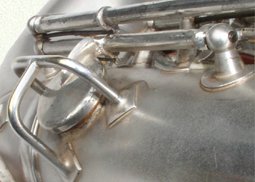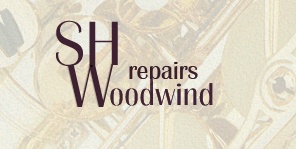King C Melody saxophone
 Origin:
USA Origin:
USA
Guide price: £400
Weight: -
Date of manufacture: Mid 1920s
Date reviewed: April 2007
An unusual horn from a noted manufacturer - with
some interesting keywork...
Mention the name King to any established sax player and you can bet
that they'll rattle off names like the Super 20, the Zephyr and the Silversonic.
It's a fair bet too that they'll mention the big, fat sound that's associated
with the brand. With that in mind the prospect of a C Melody that has
some 'oomph' is quite an exciting one.
King themselves have a long and illustrious history with regard to saxophones
(and other winds in general) - and this C Melody would have been amongst
the very first models that King made.
The body is sturdy, and as well built as you'd expect for a horn of this
era.
There are few concessions to convenience; the bell is soldered on; the
action is mounted on individual pillars; the thumb hook isn't adjustable
and the bell brace is the usual thin affair that's guaranteed to drive
itself into the body (thus distorting the Auxiliary F and G tone holes)
in the event of the bell taking a hard knock head on.
King have opted for the tenor type crook - there are C Melodies that
feature an alto style crook (without the swan neck curve). Opinion is
divided as to which is best, but I tend to prefer this design. From an
aesthetic point of view it sits better with the horn too.
The toneholes are hard or silver soldered on, unlike other horns (such
as the Martins) that have soft soldered tone holes.
It could be said that this method of fitting tones holes minimises distortions
in the bore (as opposed to drawing them out), but if it makes any difference
at all on a saxophone I'm pretty sure it's negligible. Unlike soft soldered
tone hole, these ones won't be prone to falling off due to the action
of Selective Galvanic Corrosion.
I didn't notice any warped tone holes.
The guards aren't removable, being the typical 'wire' type - though they're
neat and functional...and quite solid.
The whole body is nicely finished in matt silver plate, with brightwork
on the fittings, the keys and the bell.
The keywork follows the same pattern; functional and sturdy, though
perhaps less simple. The main key stacks are mounted on single rods
- so wear is an issue to look out for here, particularly on the
right hand key stack. Proper point screws have been used throughout.
As per most saxes of this era, the King features a fantastically
complicated octave key mechanism - with lever and arms laid out
all over the place. It does the job though (somehow), though you
wouldn't call it particularly slick in operation.
 A
very curious feature of the octave key mechanism is the angle at which
the octave key pips sit - or more precisely, the holes in them. A
very curious feature of the octave key mechanism is the angle at which
the octave key pips sit - or more precisely, the holes in them.
The idea behind this was to alleviate the hissing sound that these holes
sometimes produce.
It's a completely batty idea (it's not that much of a problem anyway),
and all it really does is make it incredibly difficult to fit a pad to
the octave key cups.
This is how the pads were fitted when the horn came in, and you can see
how extreme the pad angles are.
These vintage octave key mechs can be 'approximate' in action at the best
of times, and these offset holes are probably a luxury this system can't
afford.
As an idea it was a complete waste of time, and was mercifully short-lived.
It was patented around 1925 - which gives a rough estimate for the date
of this horn's manufacture.
Another notable feature is the use of twin key cups on the G key.
This would have been to improve the tone and the tuning of the A (remember,
when you close a key, the sound comes out of the next hole down) - and
again it's an idea that didn't quite work out...though the same double
cup arrangement is still used on flutes. Furthermore, it's hellishly difficult
to get the two large pads to seat together (I had fun, I can tell you).
The lower of the two tone holes is really the G# tone hole. In effect,
this is akin to playing an A with the G# key open - it's supposed to improve
the tone and tuning of the A.
 Because
of the placement of the lower of the G's twin tone holes, the G# has been
mounted around the back. Because
of the placement of the lower of the G's twin tone holes, the G# has been
mounted around the back.
This mechanism features a very crude example of articulation by means
of nothing more than a couple of bits of twisted metal (seen dead centre
of the shot, inbetween the two spring posts).
Surprisingly enough this simple mechanism actually works quite well, and
has a very solid and sure feel to it. I'd even go so far as to say it
outperforms modern mechanisms.
It looks like it shouldn't, what with the enhanced leverage the modern
systems give - but it does. So there you go.
However, it's not a perfect world, and the placement of a fixed guard
over the G# tone hole makes it tricky to seat the pad.
The G# touchpiece itself and the bell key spatulas are the usual plain
rectangular blocks - functional, if perhaps a tad clumsy - and the single
piece C# key is inclined to be rather heavy.
Likewise, the palm key touchpieces are of the old rounded type - though
comfortable and reasonably well-placed nevertheless.
 As
usual for a horn of this period there's an Eb trill key fitted around
the rear of the horn, opposite the low D tone hole (strictly speaking
it's an Eb/C jump key). Again, it's a fairly crude mechanism - and as
such is alone more responsible for causing leaks on vintage horns than
any other mechanism (it wears, no-one wants to pay to have the mechanism
properly rebuilt, the regulation buffers compress and the pad won't close
fully). The standard trick here is to reverse spring this key (as this
one has been) so that it remains constantly closed. It's a simple and
effective fix, and can be easily reversed should the player wish to make
use of it - and cough up to have the inevitable wear fixed in the actuating
arm. As
usual for a horn of this period there's an Eb trill key fitted around
the rear of the horn, opposite the low D tone hole (strictly speaking
it's an Eb/C jump key). Again, it's a fairly crude mechanism - and as
such is alone more responsible for causing leaks on vintage horns than
any other mechanism (it wears, no-one wants to pay to have the mechanism
properly rebuilt, the regulation buffers compress and the pad won't close
fully). The standard trick here is to reverse spring this key (as this
one has been) so that it remains constantly closed. It's a simple and
effective fix, and can be easily reversed should the player wish to make
use of it - and cough up to have the inevitable wear fixed in the actuating
arm.
The action felt remarkably good under the fingers. Aside from the slightly
clunky bell keys and the old-fashioned side trills, the action moved swiftly
and positively. A great deal of this is due to the rather long springs
used on the action - there's plenty of room for tweaking, and lots of
leverage to play with. It's a great design feature that many a modern
manufacturer seems to have forgotten about.
In terms of ergonomics everything's where it ought to be, and I don't
imagine many players will have any significant problems getting around
the keys.
Tonewise the King is quite bright overall. The lower notes are rich and
full, and exhibit a satisfying crackle when played subtone.
This richness extends to the top notes, which are just as crisp and clear
- making it a very punchy horn for a C Melody.
I can't say that the tone is even though - there was very distinct dulling
of the tone going from A to G (it's probably those twin tone holes on
the G key). I wondered if perhaps this was due to the modern mouthpiece
I was using (though I hadn't noticed the same problem on the Martin
C Melody with the same mouthpiece), but the problem remained when
I tried the King with a bespoke C Melody mouthpiece from aquilasax
(worth a visit to this site if you're a C Melody fan - there's news of
a brand new C Melody being built in China).
I suspect the issue is so noticeable because of the King's brightness
- were it a warmer horn in general then this dip in tone wouldn't stand
out. So much for the double key cup idea then.
I also noted some problems with the tuning.
The A was slightly sharp, and the entire lower octave slightly flat. Top
F on the palm keys was very flat indeed - though if played using the front
(or auto) F it snapped nicely into tune.
I found the same problems using a variety of mouthpieces, including the
aforementioned C Melody piece - so I'd rule out any chance of improving
matters by opting for a more sympathetic mouthpiece. I rather suspect
some work on those twin G tone holes and the top F might be the only solution.
I've always felt that the C Melody stands between the alto and the tenor
in terms of tone, and takes the worst of each - but the King goes a long
way to improving upon that notion. It's not as even-toned as the Martin,
but then the Martin doesn't have anywhere near as much 'clout'. It would
make a good screamer for an R&B player who wanted something a little
unusual - but something would have to be done about the tuning.
Further information about all matters relating to C Melody saxes can
be found on Alan Tucker's site.
|


 Origin:
USA
Origin:
USA A
very curious feature of the octave key mechanism is the angle at which
the octave key pips sit - or more precisely, the holes in them.
A
very curious feature of the octave key mechanism is the angle at which
the octave key pips sit - or more precisely, the holes in them. Because
of the placement of the lower of the G's twin tone holes, the G# has been
mounted around the back.
Because
of the placement of the lower of the G's twin tone holes, the G# has been
mounted around the back. As
usual for a horn of this period there's an Eb trill key fitted around
the rear of the horn, opposite the low D tone hole (strictly speaking
it's an Eb/C jump key). Again, it's a fairly crude mechanism - and as
such is alone more responsible for causing leaks on vintage horns than
any other mechanism (it wears, no-one wants to pay to have the mechanism
properly rebuilt, the regulation buffers compress and the pad won't close
fully). The standard trick here is to reverse spring this key (as this
one has been) so that it remains constantly closed. It's a simple and
effective fix, and can be easily reversed should the player wish to make
use of it - and cough up to have the inevitable wear fixed in the actuating
arm.
As
usual for a horn of this period there's an Eb trill key fitted around
the rear of the horn, opposite the low D tone hole (strictly speaking
it's an Eb/C jump key). Again, it's a fairly crude mechanism - and as
such is alone more responsible for causing leaks on vintage horns than
any other mechanism (it wears, no-one wants to pay to have the mechanism
properly rebuilt, the regulation buffers compress and the pad won't close
fully). The standard trick here is to reverse spring this key (as this
one has been) so that it remains constantly closed. It's a simple and
effective fix, and can be easily reversed should the player wish to make
use of it - and cough up to have the inevitable wear fixed in the actuating
arm.